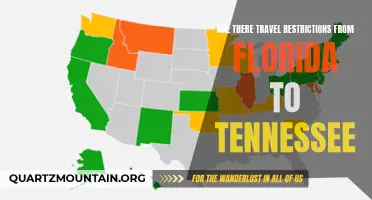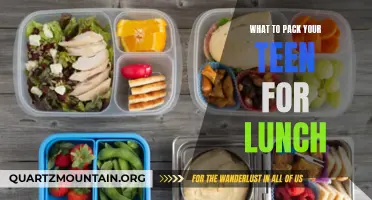
Planning a weekend hike? Don't forget to pack the essentials! Whether you're a seasoned hiker or just starting out, having a well-packed bag can make all the difference. From the right clothing to essential gear, our packing list will ensure you have everything you need for a successful and enjoyable adventure in the great outdoors. So lace up your boots, grab your backpack, and let's hit the trails!
| Characteristics | Values |
|---|---|
| Clothing | Comfy, breathable, moisture-wicking |
| Footwear | Sturdy hiking boots, extra socks |
| Backpack | Lightweight, roomy, with waist and chest straps |
| Water | Hydration pack, water bottles |
| Food | Lightweight, high-energy snacks |
| Navigation | Map, compass, GPS device |
| First Aid Kit | Band-aids, antiseptic, pain relievers |
| Shelter | Tent, sleeping bag, sleeping pad |
| Sleeping Gear | Sleeping bag liner, pillow |
| Cooking Gear | Stove, pot, utensils, fuel |
| Safety Gear | Headlamp, whistle, fire starter |
| Toiletries | Toilet paper, hand sanitizer |
| Extra Supplies | Extra batteries, duct tape, multi-tool |
| Communication | Cell phone, emergency contact info |
| Entertainment | Book, playing cards, camera |
| Bug Protection | Bug spray, mosquito net |
| Clothing Layers | Hat, gloves, rain jacket |
| Trekking Poles | Adjustable, lightweight, durable |
What You'll Learn
- What are the essential items to pack for a weekend hike?
- How should I prioritize packing different types of clothing?
- Are there any specific gear or equipment recommendations for a weekend hike?
- Are there any important safety items that should be included in my packing list?
- How can I pack efficiently to ensure I have everything I need without carrying too much weight?

What are the essential items to pack for a weekend hike?
When preparing for a weekend hike, it is important to pack the right items to ensure a safe and enjoyable outdoor experience. Whether you are a seasoned hiker or a beginner, having the right gear can make all the difference. In this article, we will discuss the essential items that should be included in your backpack for a weekend hike.
First and foremost, a sturdy backpack is essential for carrying all your gear. Look for a backpack that is comfortable to wear, has adjustable straps and plenty of storage space. It should also be made of durable materials that can withstand the elements.
Next, you will need a good pair of hiking boots. These should provide ankle support and a solid grip on different terrains. It is important to choose boots that are comfortable and properly fitted to avoid blisters and foot pain. Don't forget to break in your boots before hitting the trail to minimize the risk of discomfort.
In addition to your boots, packing the right clothing is essential. Dressing in layers is key as temperatures can fluctuate throughout the day. Start with a moisture-wicking base layer that will keep you dry and comfortable. Add a mid-layer for insulation, and finish with a waterproof and windproof outer layer to protect against the elements. Don't forget to pack extra socks and a hat to keep your head warm or shaded.
When it comes to gear, a reliable map and compass are essential for navigation. It is important to know how to use these tools before heading out on a hike. In addition, a GPS device or smartphone with a hiking app can also be useful for tracking your route and getting real-time information about your surroundings.
Basic first aid supplies should also be included in your backpack. This should include bandages, adhesive tape, antiseptic wipes, painkillers, and any personal medications you may need. It is important to know how to use these supplies in case of an emergency.
Water is another essential item for a hike. It is important to stay hydrated throughout your hike, especially on hot days or when hiking at higher altitudes. Pack enough water to last the duration of your hike, and consider bringing a filtration system or water purification tablets in case you need to refill from natural sources.
Adequate food and snacks are also important for maintaining energy levels during your hike. Choose lightweight and non-perishable foods that provide a good balance of carbohydrates, protein, and fats. Trail mix, energy bars, and dried fruits are all excellent options.
Other essential items to consider include a headlamp or flashlight, a multi-tool with a knife, a whistle for emergencies, and a lightweight camping stove if you plan on cooking hot meals. It is important to be prepared for any situation that may arise during your hike.
In conclusion, when packing for a weekend hike, it is important to remember the essential items that will contribute to a safe and enjoyable experience. This includes a comfortable backpack, sturdy hiking boots, appropriate clothing, navigation tools, first aid supplies, water, food, and other necessary gear. By taking the time to pack these items, you can ensure that you are well-prepared for your outdoor adventure.
Essential Items to Pack for a Vacation to Grand Cayman
You may want to see also

How should I prioritize packing different types of clothing?
When packing for a trip, it is important to prioritize what types of clothing you should bring. This can help you to pack efficiently and ensure that you have everything you need for your journey. In this article, we will discuss how to prioritize packing for different types of clothing.
- Basic essentials: Start by packing your basic essentials. These are the items that you will need on a daily basis, such as underwear, socks, and sleepwear. Make sure to pack enough of these items to last you for the duration of your trip. It is also a good idea to pack a few extra pairs, just in case.
- Weather-appropriate clothing: Next, consider the climate and weather conditions of your destination. If you are traveling to a warm location, pack lightweight clothing such as shorts, t-shirts, and sundresses. On the other hand, if you are traveling to a cold location, pack warm clothing such as sweaters, jackets, and long pants. Don't forget to pack accessories like hats, scarves, and gloves if needed.
- Versatile clothing: When packing for a trip, it is important to maximize the use of each item. Look for clothing that can be easily mixed and matched to create different outfits. For example, pack neutral-colored pants or skirts that can be paired with different tops. This will help you to pack less overall and leave more room for other items.
- Special occasion clothing: If you have any special occasions planned during your trip, such as a fancy dinner or a wedding, make sure to pack appropriate clothing for these events. This could include a nice dress or a suit. Consider the dress code and cultural norms of your destination when choosing these items.
- Activity-specific clothing: If you have any specific activities planned during your trip, such as hiking or swimming, pack the necessary clothing and gear. This could include athletic wear, swimwear, or hiking boots. It is also a good idea to pack a small first aid kit if you will be engaging in any physical activities.
- Toiletries and accessories: Finally, don't forget to pack your toiletries and accessories. This includes items such as toothbrush, toothpaste, shampoo, conditioner, and any necessary medications. Depending on your destination, you may also need to pack items such as sunscreen, insect repellent, or a travel adapter.
In conclusion, when packing for a trip, it is important to prioritize different types of clothing based on your needs. Start by packing your basic essentials, followed by weather-appropriate clothing, versatile clothing, special occasion clothing, activity-specific clothing, and finally, toiletries and accessories. By following these steps, you can ensure that you have everything you need for a successful and enjoyable trip.
Essential Items to Pack for a Pilgrimage: A Comprehensive Guide
You may want to see also

Are there any specific gear or equipment recommendations for a weekend hike?
When planning for a weekend hike, it is important to have the right gear and equipment to ensure a comfortable and enjoyable experience. Here are some recommendations for the essential items you should have with you:
- Backpack: A sturdy and comfortable backpack is a must-have for any hiker. Look for one that has multiple compartments and a padded back and shoulder straps for added comfort. It should have enough space to carry all your gear and essentials.
- Hiking Boots: Invest in a pair of good quality hiking boots that offer ankle support and have a rugged sole for traction. Make sure they are comfortable and well-fitted to prevent blisters and discomfort during the hike.
- Clothing: Dress appropriately for the weather and consider layering your clothing to adjust for changing temperatures. Opt for moisture-wicking and quick-drying fabrics to keep you dry and comfortable. Don't forget essentials like a hat, sunglasses, and rain gear.
- Navigation Tools: Carry a map and a compass to navigate through the trails. It is also a good idea to have a GPS device or a smartphone with a reliable hiking app for additional assistance. Familiarize yourself with the route beforehand to avoid getting lost.
- Water and Food: A weekend hike can be physically demanding, so it is crucial to stay hydrated and fueled. Carry an adequate supply of water and energy-rich snacks such as trail mix, energy bars, and fruits. Plan your meals and pack lightweight camping meals if necessary.
- First Aid Kit: Accidents can happen, so it is essential to have a first aid kit with basic supplies such as adhesive bandages, gauze, antiseptic wipes, and pain relievers. Additionally, pack any personal medications you may need.
- Safety Gear: Depending on the terrain and weather conditions, you may need additional safety gear. This could include a headlamp or flashlight, a whistle for emergencies, a trekking pole for added stability, and a lightweight camping stove for cooking.
- Personal Items: Don't forget to pack personal items such as sunscreen, bug repellent, a pocket knife, a lighter or matches, toiletries, and a small towel. These small items can make a big difference in your comfort level during the hike.
Remember to pack your gear and equipment in a way that distributes weight evenly in your backpack. Test your gear and make any necessary adjustments before heading out on your weekend hike. It is also advisable to check the weather forecast and trail conditions beforehand for any last-minute changes or precautions.
In conclusion, having the right gear and equipment is essential for a successful weekend hike. These recommendations will ensure that you are prepared for any situation and can fully enjoy the beauty of nature. Happy hiking!
Essential Items to Pack for a Beach Cottage Vacation
You may want to see also

Are there any important safety items that should be included in my packing list?

When packing for a trip, it's important to consider not only what you will need for comfort and convenience, but also what you may need in case of emergencies or unexpected situations. Including a few key safety items in your packing list can provide peace of mind and ensure that you are prepared for unforeseen circumstances.
One important safety item that should be included in your packing list is a first aid kit. While you hope to never need it, having a well-stocked first aid kit can be a lifesaver in the event of an injury or illness. Your first aid kit should include items such as adhesive bandages, gauze pads, adhesive tape, antiseptic wipes, tweezers, scissors, and over-the-counter pain relievers. Additionally, if you have any specific medical conditions or allergies, it is important to pack any necessary medications or medical supplies.
Another safety item to include in your packing list is a portable phone charger or power bank. In case of an emergency, it is vital to have a way to charge your phone and stay connected. Whether you're lost, stranded, or in need of assistance, having a fully charged phone can be a lifeline. Make sure to pack a charger compatible with your phone or invest in a reliable power bank that can provide multiple charges.
A small flashlight or headlamp is also an essential safety item to include in your packing list. In the event of a power outage or if you find yourself in a dark or unfamiliar environment, having a light source can greatly improve your safety and visibility. A small, lightweight flashlight or headlamp can easily fit in your bag or pocket and be easily accessible when needed.
Additionally, it is important to consider any specific safety concerns for your destination and pack accordingly. For example, if you are traveling to a remote area or going on a hiking trip, it may be necessary to pack items such as a whistle, a compass, and a map. If you are traveling to a beach or swimming destination, consider packing a life jacket or floatation device.
Don't forget to pack a photocopy of your important documents such as your passport, identification cards, and travel insurance information. In the event that your original documents are lost or stolen, having a photocopy can make it easier to replace them or prove your identity.
In summary, including a few important safety items in your packing list can go a long way in ensuring your well-being during your travels. A first aid kit, portable phone charger or power bank, flashlight or headlamp, and any destination-specific safety items should be considered to provide peace of mind and preparedness for emergencies or unexpected situations. Remember, it's better to be safe than sorry.
What Shoes Should You Pack for an African Safari?
You may want to see also

How can I pack efficiently to ensure I have everything I need without carrying too much weight?
Packing efficiently for a trip is crucial to ensure you have everything you need without burdening yourself with excess weight. Whether you're going on a short weekend getaway or a long backpacking adventure, here are some tips to help you pack efficiently:
- Make a packing list: Before you start packing, create a comprehensive checklist of all the items you will need for your trip. This will help you stay organized and ensure that you don't forget anything important. Divide your list into categories like clothing, toiletries, electronics, and miscellaneous items.
- Consider the weather and activities: Take into account the weather conditions and planned activities at your destination. This will help you pack appropriate clothing and gear. Check the weather forecast and research the activities you'll be participating in to determine the essentials.
- Choose versatile clothing: Select clothing items that can be mixed and matched easily. Opt for neutral colors and pack items that can be layered for various weather conditions. Consider packing clothes that can double as activewear to save space. Roll your clothes instead of folding them to maximize space in your suitcase.
- Use the 3-1-1 rule for liquids: If you're bringing toiletries, remember to follow the Transportation Security Administration (TSA)'s 3-1-1 rule for liquids. This means packing liquids, gels, and aerosols in containers of 3.4 ounces (100 milliliters) or less, all of which must fit into a single quart-sized clear zip-top bag. Be mindful of which toiletries are provided by your accommodation to avoid packing unnecessary items.
- Utilize travel-sized items: Instead of carrying full-size toiletries, invest in travel-sized versions or transfer your favorite products into small containers. Many stores offer a range of travel-sized options, including toothpaste, shampoo, and sunscreen. Alternatively, you can store these items in reusable travel bottles.
- Pack multipurpose items: Look for items that serve multiple purposes to save space and weight. For example, a sarong can be used as a towel, beach cover-up, or even a picnic blanket. A microfiber towel is lightweight, dries quickly, and can be used for both bathing and as a yoga mat. Consider packing items like a Swiss Army knife or a portable charger that can be used for a variety of situations.
- Minimize your electronics: Evaluate which electronics you truly need on your trip. Do you really need to bring a laptop, tablet, and smartphone? Consider bringing just one device that can perform multiple tasks. If you're an avid reader, an e-reader can replace several physical books, saving space and weight.
- Pack travel-friendly snacks: Carry a few compact and non-perishable snacks with you to fuel your adventures. Energy bars, nuts, or dried fruits can provide a quick boost of energy without taking up much space or adding weight to your luggage.
- Wear your bulkiest items: When possible, wear your heaviest or bulkiest clothing items during travel. This may include wearing your hiking boots or a thick sweater. Wearing these items instead of packing them will free up space and reduce the weight of your luggage.
- Weigh your luggage: Before leaving for your trip, weigh your luggage to ensure it complies with airline weight restrictions. This will help you avoid any unexpected fees or the hassle of repacking at the check-in counter.
By following these tips, you can pack efficiently for your trip, ensuring that you have everything you need without being weighed down by excess baggage. Remember to plan ahead, make a packing list, and prioritize versatility and multipurpose items. Happy travels!
Essential Items to Pack for a Three-Day Winter Trip in New York City
You may want to see also
Frequently asked questions
For a weekend hike, it's important to pack clothing that is suitable for the weather conditions. This includes lightweight and breathable layers such as a moisture-wicking t-shirt, a long-sleeve shirt, and a warm fleece or jacket for cooler temperatures. Don't forget comfortable hiking pants or shorts, socks that wick away moisture, and sturdy hiking boots.
When packing for a weekend hike, make sure to include essentials such as a map and compass, a first aid kit, a headlamp or flashlight, a multi-tool, sunscreen, insect repellent, a whistle, and a fire starter. Water bottles or a hydration bladder, as well as high-energy snacks, should also be included.
It's important to bring enough food and water to keep you hydrated and energized during your weekend hike. Aim for at least 2 liters of water per day, and bring lightweight, non-perishable foods such as energy bars, trail mix, and dehydrated meals that can be easily prepared on the trail.
In addition to clothing and essentials, there are several types of gear that you should pack for a weekend hike. This includes a lightweight and durable backpack, a lightweight and compact tent, a sleeping bag rated for the expected temperatures, a sleeping pad for added comfort, and trekking poles for stability on uneven terrain.
When packing for a weekend hike, it's also important to consider additional items that can enhance your experience. This could include a camera to capture the beautiful scenery, a portable charger for your electronic devices, a portable camping stove for cooking meals, a sit pad for added comfort during breaks, and a book or playing cards for entertainment at camp.







